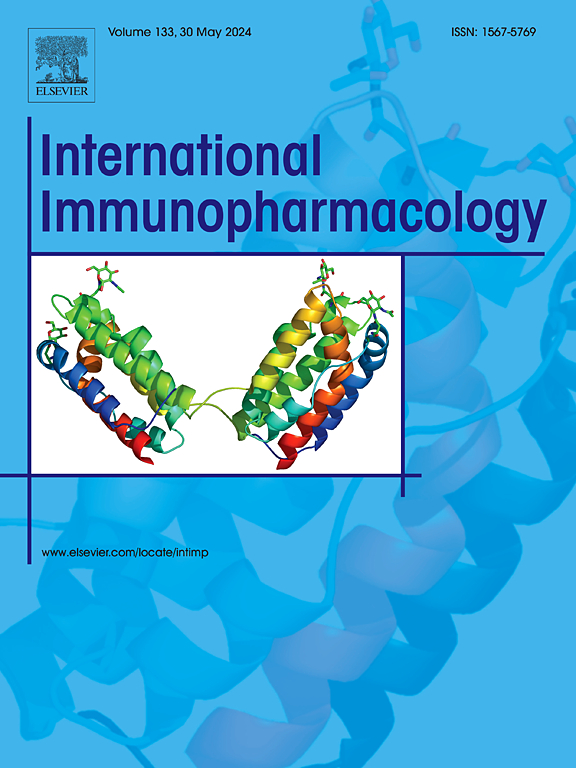Ex vivo pembrolizumab pharmacology for personalized PD-1 inhibitor therapy reveals a critical gap between receptor occupancy and T cell functionality
IF 4.8
2区 医学
Q2 IMMUNOLOGY
引用次数: 0
Abstract
Purpose
Targeting the programmed death (ligand)-1 (PD-1/PD-L1) axis with immune checkpoint inhibitors (ICIs), like pembrolizumab, has improved cancer survival. Unfortunately, the optimal dose remains unknown and less than 50 % of patients respond. Understanding PD-1 receptor pharmacology and developing early-response biomarkers are crucial to personalize therapy. We hypothesize that characterizing individual pre-treatment variability in immune responses to pembrolizumab will enhance PD-1 receptor pharmacology insights and improve treatment response prediction. Hence, this study evaluates the performance of a newly developed ex vivo immunopharmacological bioassay under healthy and pathological states.
Methods
Peripheral blood mononuclear cells from healthy individuals and non-small cell lung cancer (NSCLC) patients were stimulated in vitro in the presence of pembrolizumab. PD-1 expression, interleukin-2 (IL-2) secretion, T cell differentiation, expression of activation markers and phosphorylation of T cell signalling molecules were analysed.
Results
In healthy individuals, receptor saturation occurred at >0.025 μg/mL pembrolizumab. Yet IL-2 production still increased significantly beyond this concentration. NSCLC patients showed significantly higher PD-1 expression and IL-2 production than healthy individuals. Nevertheless, pembrolizumab induced IL-2 production similarly in both cohorts. In NSCLC patients, pembrolizumab inhibited differentiation towards CD4 central memory T cells. Remarkably, phosphorylation of proximal phospho-markers in response to pembrolizumab varied between NSCLC patients, potentially discriminating responders from non-responders.
Conclusions
We highlight the importance of evaluating T cell functionality alongside PD-1 receptor occupancy. We identified PD-1-induced modulation of phosphorylation of proximal signalling molecules as potential predictors for ICI treatment response in NSCLC. We recommend further development of this immunopharmacological bioassay for personalization of ICI treatment.

派姆单抗用于个性化PD-1抑制剂治疗的体外药理学揭示了受体占用和T细胞功能之间的关键差距
目的:利用免疫检查点抑制剂(ICIs)靶向程序性死亡(配体)-1 (PD-1/PD-L1)轴,如派姆单抗,可以提高癌症生存率。不幸的是,最佳剂量仍然未知,不到50%的患者有反应。了解PD-1受体药理学和开发早期反应生物标志物对个性化治疗至关重要。我们假设表征个体对派姆单抗免疫反应的治疗前变异性将增强PD-1受体药理学见解并改善治疗反应预测。因此,本研究评估了新开发的体外免疫药理学生物测定在健康和病理状态下的性能。方法用派姆单抗体外刺激健康人及非小细胞肺癌(NSCLC)患者外周血单个核细胞。分析PD-1表达、白细胞介素-2 (IL-2)分泌、T细胞分化、活化标志物表达及T细胞信号分子磷酸化情况。结果在健康个体中,派姆单抗在0.025 μg/mL时发生受体饱和。然而,IL-2的产生仍然显著高于这一浓度。非小细胞肺癌患者的PD-1表达和IL-2的产生明显高于健康个体。然而,在两个队列中,派姆单抗诱导IL-2产生相似。在非小细胞肺癌患者中,派姆单抗抑制向CD4中枢记忆T细胞的分化。值得注意的是,对派姆单抗的近端磷酸化标记物在NSCLC患者中有所不同,这可能区分有反应者和无反应者。我们强调了评估T细胞功能和PD-1受体占用的重要性。我们发现pd -1诱导的近端信号分子磷酸化调节是非小细胞肺癌ICI治疗反应的潜在预测因素。我们建议进一步发展这种免疫药理学生物测定,以实现ICI治疗的个性化。
本文章由计算机程序翻译,如有差异,请以英文原文为准。
求助全文
约1分钟内获得全文
求助全文
来源期刊
CiteScore
8.40
自引率
3.60%
发文量
935
审稿时长
53 days
期刊介绍:
International Immunopharmacology is the primary vehicle for the publication of original research papers pertinent to the overlapping areas of immunology, pharmacology, cytokine biology, immunotherapy, immunopathology and immunotoxicology. Review articles that encompass these subjects are also welcome.
The subject material appropriate for submission includes:
• Clinical studies employing immunotherapy of any type including the use of: bacterial and chemical agents; thymic hormones, interferon, lymphokines, etc., in transplantation and diseases such as cancer, immunodeficiency, chronic infection and allergic, inflammatory or autoimmune disorders.
• Studies on the mechanisms of action of these agents for specific parameters of immune competence as well as the overall clinical state.
• Pre-clinical animal studies and in vitro studies on mechanisms of action with immunopotentiators, immunomodulators, immunoadjuvants and other pharmacological agents active on cells participating in immune or allergic responses.
• Pharmacological compounds, microbial products and toxicological agents that affect the lymphoid system, and their mechanisms of action.
• Agents that activate genes or modify transcription and translation within the immune response.
• Substances activated, generated, or released through immunologic or related pathways that are pharmacologically active.
• Production, function and regulation of cytokines and their receptors.
• Classical pharmacological studies on the effects of chemokines and bioactive factors released during immunological reactions.

 求助内容:
求助内容: 应助结果提醒方式:
应助结果提醒方式:


